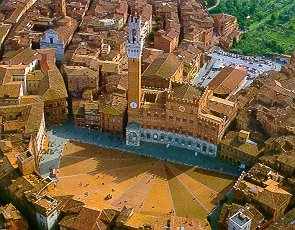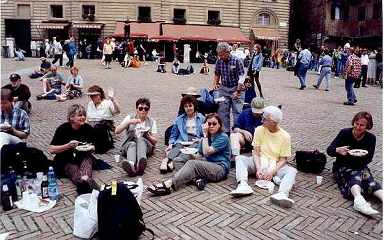
The next morning we were led by a local guide on a tour of Siena. She was very knowledgeable about the history of Siena, its architecture, its customs, and she was entertaining as well, keeping our interest for over 2 hours. Our first stop was outside a bank building where she told us about the importance of Siena in its early days since it was on an important trade route. Another stop was at the famous piazza del Campo, a large fan-shaped piazza where the famous Palio horse races are held each year.

The Sienese are not only citizens of Siena, but are even more closely tied to their contrade or parish. On our walk into the city the previous evening we had seen a number of people from the contrade named "Goose" practice their flag twirling for an upcoming event. On this day we walked through that contrade again and every building had the flag of that contrade and there were many men building stands for a celebration to be held that evening. Some of the group went to that celebration, a baptism of children into that contrade. In Siena children are baptised both in the church and in their contrade.


Our tour also took us to the Duomo, whose interior has alternating bands of black and white marble. The 15th-16th century floors are unique. There are 56 marble panels, some are geometric and some portray scenes such as the "Slaughter of the Innocents".


After an hour or so of free time, we met again in the Campo for a picnic lunch our tour guides provided. It included specialties of the area: their cheeses, boar sausage, porchetta, tomatoes, cucumbers, beans, chard, beer, and wine.


In free time in the afternoon, some visited the Palazzo Publico, a beautiful Gothic building built in the 13th-14th century. This palace had been the seat of government and had been decorated by some of the great artists of the Sienese school. Some of the most famous works there were the Maesta by Martini and the Effects of Good and Bad Government.
Back to home page.